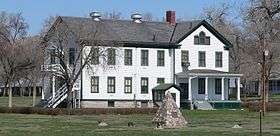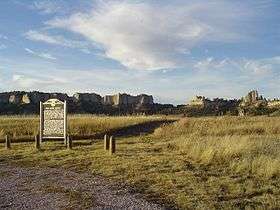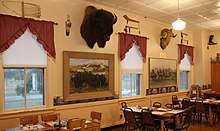Fort Robinson
| Fort Robinson State Park | |
| Nebraska State Park | |
 Post headquarters at Fort Robinson | |
| Country | |
|---|---|
| State | |
| Counties | Dawes, Sioux |
| Elevation | 3,806 ft (1,160 m) [1] |
| Coordinates | 42°40′02″N 103°27′56″W / 42.66722°N 103.46556°WCoordinates: 42°40′02″N 103°27′56″W / 42.66722°N 103.46556°W [1] |
| Area | 22,604 acres (9,148 ha) [2] |
| Established | 1956 |
| Management | Nebraska Game and Parks Commission |
|
Location in Nebraska | |
| Website: Fort Robinson State Park | |
|
Fort Robinson and Red Cloud Agency | |
 Site of the second Red Cloud Agency | |
| Location | Dawes and Sioux counties, Nebraska, U.S. |
| Nearest city | Crawford, Nebraska |
| Area | 2,500 acres (10.1 km2)[3] |
| Built | 1873 |
| NRHP reference # | 66000442 |
| Significant dates | |
| Added to NRHP | October 15, 1966 |
| Designated NHLD | December 19, 1960[4] |
Fort Robinson is a former U.S. Army fort and a major feature of Fort Robinson State Park, a 22,000-acre (8,900 ha) public recreation and historic preservation area located 2 miles (3.2 km) west of Crawford on U.S. Route 20 in the Pine Ridge region of northwest Nebraska. The fort was declared a National Historic Landmark in 1960 and is part of the Fort Robinson and Red Cloud Agency historic district, which includes Fort Robinson and the site of the second Red Cloud Agency (about 1.5 mi (2.4 km) to the east). The district also includes the Camp Camby site and the 1886 Percy Homestead.[3] The fort is managed by the Nebraska Game and Parks Commission, with some individual buildings operated by the Nebraska State Historical Society and the University of Nebraska.[5]
History
In August 1873, the Red Cloud Agency was moved from the North Platte River to the White River, near what is now Crawford, Nebraska, in the northwest corner of the state. The following March, the U. S. Government authorized the establishment of a military camp at the agency site. Some 13,000 Lakota had been resettled at the Agency, some of them hostile. There were continuing tensions on the Great Plains between whites and Lakota who had been forced off much of their territory.
The camp was named Camp Robinson in honor of Lt. Levi H. Robinson, who had been killed by Indians while on a wood detail in February. In May, the military camp was moved 1.5 miles (2.4 km) west of the agency to its present location; the camp was renamed Fort Robinson in January 1878.
Fort Robinson played a major role in the Sioux Wars from 1876 to 1890. The Battle of Warbonnet Creek took place nearby in July 1876. Crazy Horse surrendered here with his band on May 6, 1877. On September 5 that year, he was fatally wounded while resisting imprisonment.[6] A historic plaque marks the site of his death.
In January 1879, Chief Morning Star (also known as Dull Knife) led the Northern Cheyenne in an outbreak from the Agency. Because the Cheyenne had refused to return to Indian Territory, where they believed conditions were too adverse for them to survive, the army had been holding them without adequate food, water or heat during the severe winter to try to force them into submission. Soldiers hunted down the escapees, killing men, women, and children in the Fort Robinson massacre. The U.S. Supreme Court called the "shocking story" "one of the most melancholy of Indian tragedies".[7] The event marked the end of the Sioux and Cheyenne Wars in Nebraska.
In 1885, the 9th Cavalry Regiment, nicknamed the Buffalo Soldiers by Native Americans, was stationed at Fort Robinson. This was an all-black unit. During the next several years, the fort was enlarged, and military training was a major activity. From 1889-1890, Second Lieutenant Charles Young served here and later was reassigned to the regiment. A black pioneer officer who had graduated from West Point, he was the highest-ranking black in the US Army throughout his career and achieved the rank of colonel.[8] From 1887-1898, the fort served as regimental headquarters. The post gymnasium and theatre, built in 1904, provided entertainment for the soldiers.[3]
In 1919 at the end of World War I, Fort Robinson became the world's largest quartermaster remount depot. It was used as a breeding and training center for horses and mules for the military. In addition, stallions owned by the military were used to breed with local stock to improve it. During the Great Depression, a hobo was murdered on a Chicago & Northwestern freight train within the fort.[9] In World War II, the fort was the site of a K-9 corps training center. Later it was used to hold a German prisoner-of-war camp.[10]
- Closing
The U.S. Army decided to abandon Fort Robinson in 1947; in the following year, it transferred the property to the U.S. Department of Agriculture (USDA), for its Beef Cattle Research Station. In the mid-1950s, efforts were made to preserve the fort as a historic site, prompted by the demolition of buildings. In 1955, the Nebraska State Historical Society began to acquire property on the fort; in 1956, they opened a museum on the site. The USDA closed its operation in 1971, transferring the property to the state of Nebraska.[3][11][12]
- State park
The Fort Robinson State Park was established in 1956 following the purchase of a parcel of land by the Nebraska Game, Forestation and Parks Commission in 1955. The park grew when much of the site was deeded over from the Federal government in 1964. It reached its full size with the purchase of the adjoining James Arthur Ranch in 1972.[2]
Features

The fort's historic buildings and sites include the 1904 blacksmith shop, the 1908 veterinary hospital, the 1887 officers' quarters, the 1875 guardhouse and adjutant's office, and the post cemetery. There is also a library with materials about Fort Robinson and military and western history available for research. A quartermaster's stores building is now used as a playhouse.[3]
The Fort Robinson Museum is located in the 1905 post headquarters building. Exhibits focus on the fort's history, including its role guarding the Red Cloud Agency from 1874 to 1877, up through the housing of World War II German POWs from 1943 to 1946.[13] The Trailside Museum of Natural History, operated by the University of Nebraska State Museum, is located in the historic Army Theatre building.[14]
Further reading
- Barnes, Jeff. Forts of the Northern Plains: Guide to Historic Military Posts of the Plains Indian Wars. Mechanicsburg, PA: Stackpole Books, 2008. ISBN 978-0811734967
- Buecker, Thomas R. Fort Robinson and the American West, 1874-1899. Norman, OK: University of Oklahoma, 2003. ISBN 0806135344
- Buecker, Thomas R. Fort Robinson and the American Century, 1900-1948. Lincoln, NE: Nebraska State Historical Society, 2002. ISBN 0806136464
References
- 1 2 "Fort Robinson State Park". Geographic Names Information System. United States Geological Survey.
- 1 2 "Fort Robinson Management Plan 2013–2023" (PDF). Nebraska Game and Parks Commission. p. 4. Retrieved May 15, 2017.
- 1 2 3 4 5 Steven Lissandrello and Sarah J. Pearce (July 20, 1983). "Fort Robinson and Red Cloud Agency". National Register of Historic Places Inventory Nomination Form. National Park Service. and "Accompanying 63 photos from 1975 and 1983, and 2 historic photos of Red Cloud"
- ↑ "Nebraska" (PDF). Listing of National Historic Landmarks by State. National Park Service. Retrieved May 15, 2017.
- ↑ "Fort Robinson State Park". Nebraska Game and Parks Commission. Retrieved May 15, 2017.
- ↑ Bucker, Thomas L. "Final Days of Crazy Horse". Friends of the Little Bighorn Battlefield. Retrieved September 5, 2012.
- ↑ "Conners v. United States, 180 U.S. 271, 21 S. Ct. 362, 45 L. Ed. 525 (1901)". Justia. Retrieved March 24, 2015. (Justice Henry Billings Brown finding no federal liability.)
- ↑ Brian G. Shellum, (2010). Black Officer in a Buffalo Soldier Regiment: The Military Career of Charles Young. Lincoln, Neb.: University of Nebraska. p. xi. ISBN 0803230222. Retrieved June 9, 2010.
- ↑ "United States v. Unzeuta, 281 U.S. 138, 50 S. Ct. 284, 74 L. Ed. 761 (1930)". Justia. Retrieved March 24, 2015. (Chief Justice Charles Evans Hughes finding federal jurisdiction.)
- ↑ "Prisoner of War Camp". Nebraska State Historical Society. Retrieved August 8, 2005.
- ↑ "Fort Robinson Timeline". Nebraska State Historical Society. Retrieved February 7, 2013.
- ↑ "Fort Robinson History". Nebraska State Historical Society. Retrieved August 8, 2005.
- ↑ "Fort Robinson Museum". Nebraska State Historical Society. Retrieved February 7, 2013.
- ↑ "Trailside Museum of Natural History". University of Nebraska State Museum. Retrieved May 15, 2017.
See also
External links
| Wikimedia Commons has media related to Fort Robinson. |
- Fort Robinson State Park - Nebraska Game and Parks Commission
- Fort Robinson History Center - Nebraska Historical Society
- Trailside Museum of Natural History at Fort Robinson - University of Nebraska
- Fort Robinson Park Map